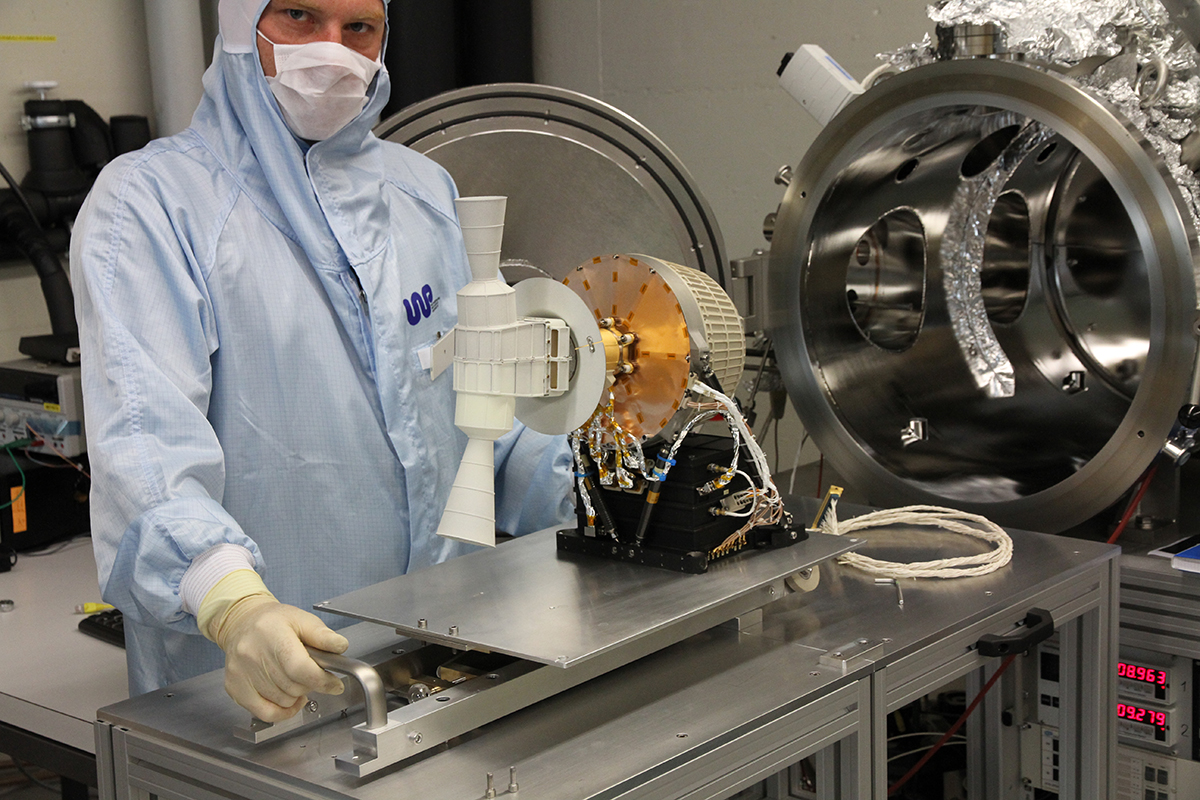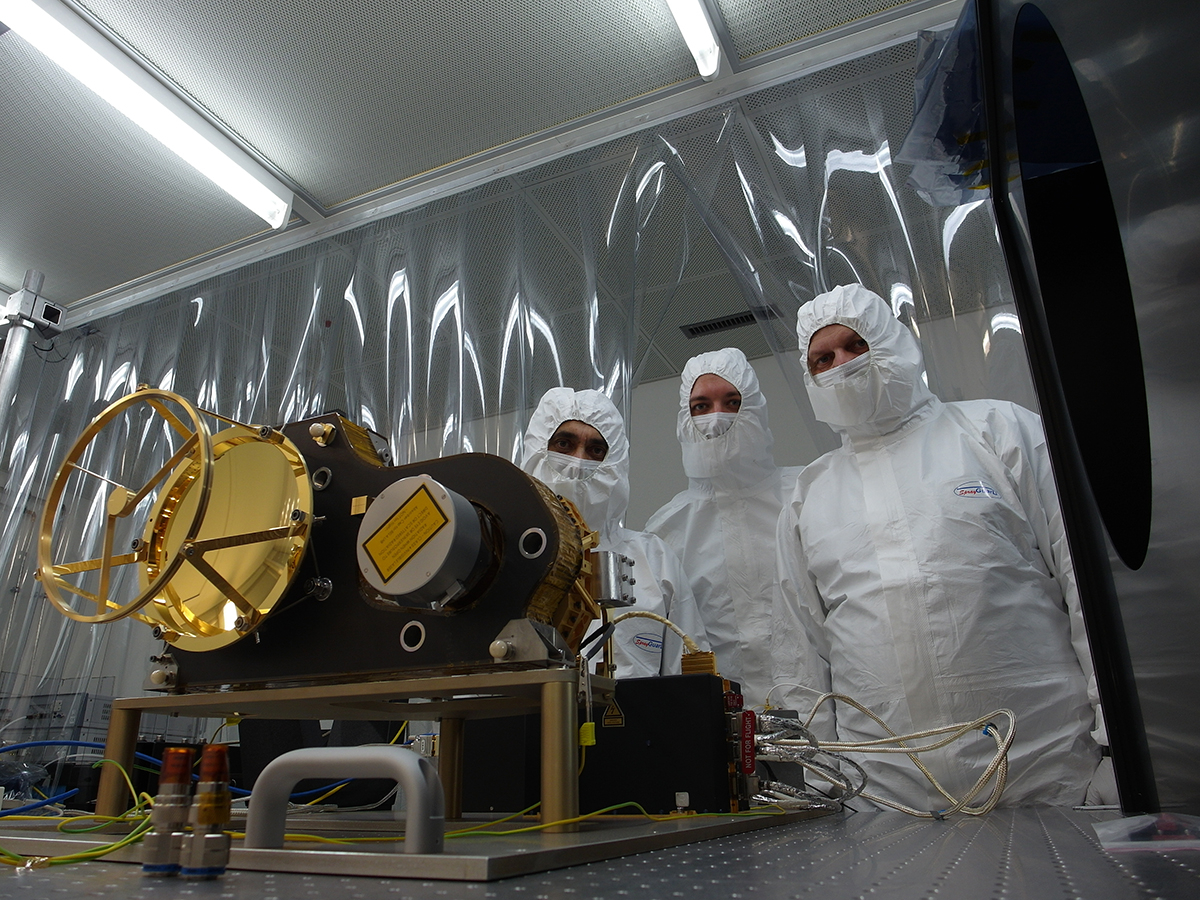Venus flyby on the way to Mercury
The space probe BepiColombo, which is on its way to Mercury, will fly past Venus on October 15, 2020 – one of the deceleration maneuvers to bring the probe into orbit in front of Mercury. BepiColombo has instruments on board which were designed and built at the Physics Institute of the University of Bern. Data is now being collected on Venus on the way to Mercury using other instruments that the Bern researchers are involved in.
On Saturday, October 20, 2018, the BepiColombo space probe set off on its journey to Mercury from the European spaceport in Kourou, French Guiana. The 6.40 meters high and 4.1 tons heavy BepiColombo space probe consists of two spacecraft: the Mercury Planetary Orbiter (MPO), which was constructed by the European Space Agency, ESA, and the Mercury Magnetospheric Orbiter (MMO), which was constructed by the Japan Aerospace Exploration Agency, JAXA. Both spacecraft will fly to Mercury together as a coupled system, but will be put onto separate orbits upon arrival. The MMO will study the magnetospheric interaction between the planet and the solar wind. The MPO will be lowered to a deeper orbit, which is ideal for the remote sensing of the planetary surface.
Unavoidable maneuvers on a long journey
The European-Japanese space probe’s journey to Mercury, the smallest planet in our solar system, will take seven years. Once BepiColombo has achieved its intended orbit, data transmission to Earth will take approximately 15 minutes. Ultimately, the scientific investigations and experiments on Mercury should take one to two years. BepiColombo has instruments on board which were designed and built at the Physics Institute of the University of Bern.
The journey must be made via detours: "On its way to Mercury, BepiColombo flies past Venus twice and Mercury six times to slow down the spacecraft against the gravitational pull of the Sun so that the spacecraft can be brought into orbit around Mercury," explains Peter Wurz, Professor at the University of Bern Physics Institute and co-head of the Department of Space Research and Planetology. On October 15, in the early hours of the morning, the space probe will fly past Venus for the first time at a distance of 11,000 km, the second flyby is planned for August 2021.
Data on Venus expected
On board the BepiColombo is among others the SERENA Experiment, which consists of four instruments. "SERENA also includes the innovative mass spectrometer STROFIO, which we contributed to most", says Peter Wurz, who is also the STROFIO project leader. "With STROFIO, we will record the very thin atmosphere of Mercury one day — we speak of an 'exosphere' — and analyze its chemical composition."
The Venus flyby is not only being used to decelerate but also for measurements. In addition to STROFIO, the University of Bern is also involved in two other SERENA instruments, the MIPA and PICAM. "We are expecting data from the ionized particles in Venus' atmosphere from these two instruments, which are switched on during the Venus flyby," explains Wurz. The Sun and the solar wind carry ionized particles from the outermost edge of Venus' atmosphere. "The amount of particle loss and its composition can be determined using the two instruments," Peter Wurz continues.
Sought-after Bernese expertise for over 50 years
Over the decades, the University of Bern has repeatedly shown that very high-quality instruments for space research can be built here," says Peter Wurz. "The University of Bern has always been a reliable partner in these numerous international collaborations. Which is why we're always being asked to undertake new missions to exciting destinations in the solar system."
The BepiColombo missionThe BepiColombo mission consists of two spacecraft, the Mercury Planetary Orbiter (MPO), which was constructed and built by the European Space Agency, ESA, and the Mercury Magnetospheric Orbiter (MMO), which was constructed and built by the Japan Aerospace Exploration Agency, JAXA. The two spacecraft will fly to Mercury together in a coupled system until they reach Mercury's orbit. The MMO will then be placed in an orbit of 400 km x 19,200 km to study the magnetospheric interaction between the planet and the solar wind in detail. The MPO will be lowered to an orbit of 400 km x 1,500 km, which is ideal for the remote sensing of the planetary surface. |
Bernese instruments on board BepiColomboBepiColombo has instruments on board which were designed and built at the Physics Institute of the University of Bern: The BELA laser altimeter and the innovative STROFIO mass spectrometer. The STROFIO mass spectrometer is part of SERENA on board the MPO. The aim of SERENA is the complete characterization of particle populations, ions and neutral particles, in the vicinity of Mercury under the influence of solar radiation and solar wind. The project leader of STROFIO is Peter Wurz from the Physics Institute at the University of Bern. The BELA laser altimeter is one of the most important and most sensitive experiments on board the MPO. The aim is to measure the shape, topography and morphology of the surface of Mercury. BELA was developed by an international consortium under the management of the University of Bern and the German Aerospace Center (DLR). However, BELA will not be switched on during the current Venus flyby. Nicolas Thomas, Director of the Physics Institute at the University of Bern, is co-project leader of BELA. Peter Wurz and Nicolas Thomas were involved in the BepiColombo mission from the very beginning: The two space researchers from Bern were part of the ESA Science Advisory Group that designed this mission. "One of the biggest challenges of the mission is the heat which we can expect on Mercury due to its proximity to the sun," says Nicolas Thomas. The researchers at the University of Bern had to design and build the instruments in such a way that they are able to withstand the heat of the sun which, on Mercury, can be ten times that what it is on Earth.
|
Funding by the SERI / Swiss Space OfficeThe BepiColombo mission would not be possible without the support of the SERI / Swiss Space Office and Switzerland's participation in ESA. The SERI provided financial support for the development of scientific instruments in particular. Important contributions and/or partial supplies of all instruments developed in Switzerland under the leadership of the University of Bern came from Swiss industry. No less than 20 companies contributed to the development, design and construction of the scientific instruments. The PRODEX program, under which scientific instruments or subsystems are provided, requires industrial participation of at least 50% in the overall project. This condition facilitates the transfer of knowledge and technology from and to industry and gives Switzerland as a business location a structural competitive advantage – not least thanks to spill-over effects on the other sectors of the companies involved. Swiss participations in ESA programs permit Swiss actors from science and business to position themselves in an ideal manner in corresponding ESA activities. |
Bernese space exploration: With the world’s elite since the first moon landingWhen the second man, "Buzz" Aldrin, stepped out of the lunar module on July 21, 1969, the first thing he did was to unfurl the Bernese solar wind sail and plant it into the ground on the moon, even before the American flag. This Solarwind Composition experiment (SWC) which was planned and the results analyzed by Prof. Dr. Johannes Geiss and his team from the Physics Institute of the University of Bern was the first great highlight in the history of Bernese space exploration. Bernese space exploration has been working with the world’s elite since then. The resulting numbers are impressive: Instruments have flown into the upper atmosphere and ionosphere with rockets 25 times (1967-1993), 9 times into the stratosphere on balloon flights (1991-2008), over 30 instruments have flown on space probes, and with CHEOPS the University of Bern is sharing responsibility with the ESA for a whole mission. The successful work of the Department of Space Research and Planetary Sciences (WP) from the Physics Institute of the University of Bern was consolidated by the foundation of a university competence center, the Center for Space and Habitability (CSH). The Swiss National Fund also awarded the University of Bern the National Center of Competence in Research (NCCR) PlanetS, which it manages together with the University of Geneva. |
2020/10/14




